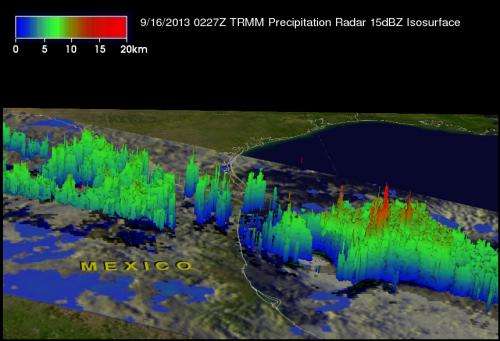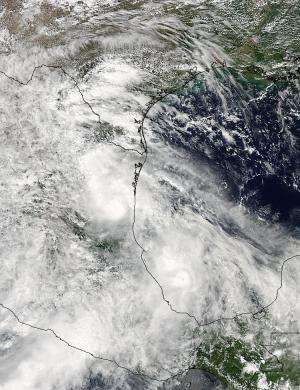TRMM satellite animation gives flyby of Tropical Storm Ingrid's heavy rains

NASA's Tropical Rainfall Measuring Mission satellite known as TRMM can compile the rain in which rain is falling as it orbits from space. When it passed over Tropical Storm Ingrid on Sept. 16 TRMM gathered data and it was used to create a NASA 3-D flyby of the storm.
When NASA's TRMM satellite flew over Tropical Storm Ingrid on Sept. 16, it was drenching the Atlantic side in the Gulf of Mexico. On Sept. 16, Hurricane Ingrid weakened to a tropical storm and came ashore from the Gulf of Mexico into the state of Tamaulipas near La Pesca, Mexico. Today, Sept. 17, Ingrid's heavy rainfall continues as the storm weakened to a remnant low pressure area over eastern Mexico.
TRMM satellite data from Sept. 16 at 0227 UTC (Sept. 15 at 10:27 p.m. EDT) were used to create a 3-D image of Ingrid's rainfall. That 3-D image of Tropical Storm Ingrid's rainfall showed heaviest rainfall appeared over the Gulf of Mexico, where rain was falling at a rate of 2 inches/50 mm per hour. Moderate rainfall stretched from the Gulf northwest and inland over eastern Mexico.
The National Hurricane Center issued the final advisory on the remnants of Ingrid on Tuesday, Sept. 17 at 5 a.m. EDT. At that time Ingrid's remnants were located near latitude 23.7 north and longitude 99.9 west about 50 miles/75 km west of Ciudad Victoria, Mexico. The remnant low pressure area and associated showers and thunderstorms were moving westward at 5 mph/ 7 kph. Ingrid's maximum sustained winds have decreased to near 25 mph/35 kph.

The National Hurricane Center noted that the remnants of Ingrid are expected to produce 10 to 15 inches of rain over a large part of eastern Mexico with isolated amounts of 25 inches possible, especially in areas of mountainous terrain. That rainfall from Ingrid's remnants is expected to cause flooding and mud-slides over eastern Mexico for the next few days.
Provided by NASA's Goddard Space Flight Center




















